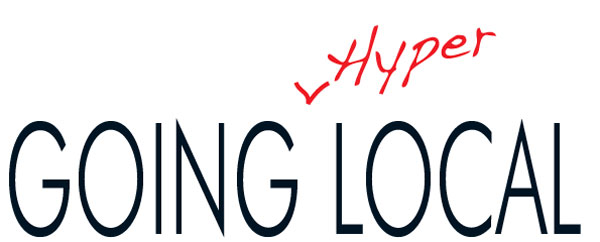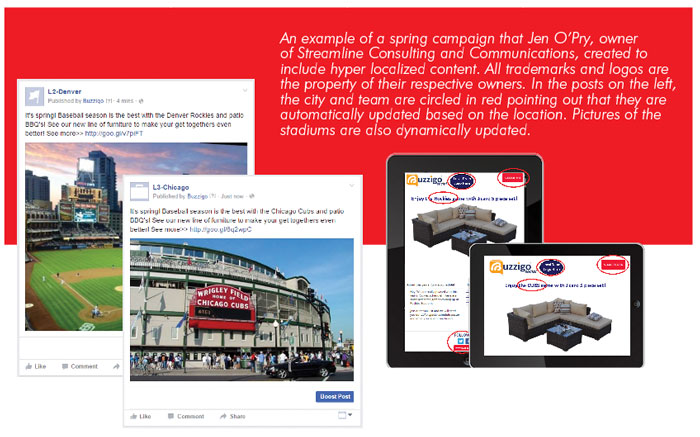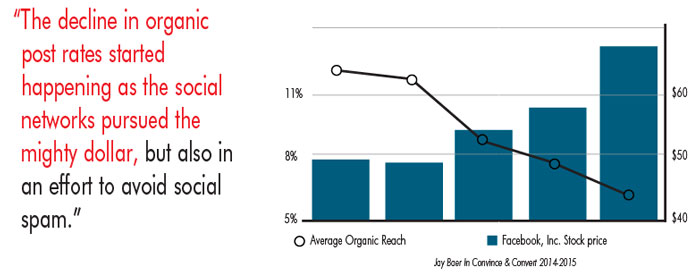
What’s Hyper Local Social Marketing, and Why Does It Matter?
by Jay Bojan
Getting on board with social media marketing and keeping up with it has been crazy, if not daunting for some marketers. In the early days, the general message was, ‘you can’t sell on social media’. Now the popular social networks have morphed into complete ad platforms.
Without question, social media has blossomed to define one of the most amazing transitions in advertising!
The root cause of this transition stems from the fact that social media is becoming a primary source of information for consumers with mobile devices in hand. In fact, according to “Wearesocial 2016”, of the 382M Americans, 223M are active internet users and 80% of those have smartphones. Fifty percent of smartphone owners say they immediately grab their smartphone upon waking up.
Social media has taken its place amongst traditional advertising channels with 192M or 68% of the active US internet users also being active social media users. 77% of those active social media users are women using Facebook, followed by 66% men. From this data, it has been derived that 51% of Facebook users are more likely to buy products and services from the brands that they follow. The tables have fully turned!
With that said, when a company’s TV ad is playing, even if customers haven’t fast forwarded through the commercials, they are distracted by their phones and tablets.
Decline in Organic Reach
The reality is that social media represents a great opportunity for furniture retailers to reach their primary audiences. There are challenges, and the biggest of these is a decline in organic “reach”. Reach is a measure of the number of users that see a post. Over the past few years the likelihood of an organic (free) post being seen by the company’s target audience on one of their timelines has declined into single digits.
Users who engage with posts by liking, commenting or re-tweeting are far more likely to see new posts due to newer social media algorithms. The decline in organic post rates started happening as the social networks pursued the mighty dollar, but also in an effort to avoid social spam. Keeping social content meaningful and relevant to users protects the value of a social platform to consumers.
To address the challenge of reaching current and potential fans head-on, Facebook offers a primary ad feature known as “boosting.” Boosting a post, page or website allows companies to reach a larger audience by defining a target audience outside of their current fans and followers, for a fee. In general, boosting is one of the most cost effective advertising techniques in use today. It costs a fraction of traditional advertising fees and is extremely effective at building audiences.

Hyper-Local Strategy
There have been a lot of changes in social media marketing lately. One of these is an emerging concept known as hyper-local social marketing.
The consumer, with phone in hand, is in control of what he or she sees and experiences. These consumers are firmly rooted in their communities. They walk around stores, streets, restaurants and parks with phones in hand.
So, a business’s future profitability is conditional on meeting its customer on his or her phone on a local, community based level, where locally relevant content drives success and effectiveness.
If a business has stores in different communities, then its social marketing will be much more effective if it does a good job of presenting locally relevant content.
A hyper local strategy starts when a single brand presence is split into multiple local identities creating an affinity between the local community, its followers and its brand. Multi-location furniture retailers are a perfect match for a hyper localized social media strategy since they have the most to gain. However, if Corporate does not have the right tools to handle this strategy, it will be difficult to manage and extremely time consuming to implement.
The difficulty comes from the fact that many of the top social media management platforms are built for a single brand presence. There are, however, solutions that automate localizing content within a social media post and associated landing pages. That way, posted content displays the right local phone number, images, city, town or sports team for each store location. Check out HubSpot, Sprout Social, Buzzigo Social and in the franchise world, FranConnect. Additionally, these tools have the advantage of automating the task of getting followers on a company’s local social media account pages.
We have seen many situations where a corporate page has hundreds of thousands, or even millions of likes and followers, but its local stores have only 29 or 75 likes. There is a correlation between the number of Facebook likes in multi-store operations and performance. Stores with under 400 Facebook likes are likely under-performing, and those reaching a threshold of 2000 are likely to be experiencing accelerated growth.

ROI Improvement
A hyper local strategy improves ROI across all advertising channels and social media is no exception. In fact, it can be more than four times more effective than generic advertising. Here are some reasons why.
- The simple mention of a location or city name in a mobile ad can improve click-through rates by 200%.1
- Historically, Yellow Pages’ display ads with local numbers yield 40% more calls than those with 800 numbers.2
- Google and others have reported CTRs over 10x typical rates on locally targeted Mobile ads featuring locally relevant data.
- National-Local advertisers have experienced 70% increases in click-through rates for ads dynamically localized and optimized versus generic ads.3
Getting Started
So how do furniture retailers engage in this strategy and benefit from hyper localization?
They follow the money by localizing social marketing. Any home furnishings retailer, from a single store to huge multi-unit franchises must connect with their communities to maintain engagement versus just selling. The place to start is to establish a separate social media page for each store location or region so that hyper localized posts can be made.
Hyper local social media marketing automation exists and can make the entire process easy, cost effective and well worth a company’s time if the right tools are used.
Becoming Relevant
A strong localized social campaign should engage brand fans, followers, and the community, addressing the reasons why people follow the brand. If you post four times a week… in our opinion just one of these posts should sell or provide an offer. Within that context, referencing a local interest story and connecting the content with the community and the target audience of a company can pay off exponentially.
The key feature necessary for success to deploy a social medial campaign to dozens or hundreds of locations is that it automatically localizes the content making it easy to drive engagement.
For example, if a store sponsors a sports team, a post might reference that team, and perhaps promote outdoor, furniture, TVs and related items being sold at a specific location. For a store in Denver, the post would mention the Colorado Rockies along with a logo as permitted. An automated system localizes the content so that a Chicago location’s post and landing page will feature the Chicago Cubs or White Sox. This kind of automatic localization can be adapted to be extremely granular.
On the following page is an example of a campaign that Jen O’Pry, owner of Streamline Consulting and Communications, created to include hyper localized content. Please note that in the illustration above all trademarks and logos are the property of their respective owners.
In the posts on the left, the city and team are circled in red pointing out that they are automatically updated based on the location; the Denver Rockies and Chicago Cubs and the pictures of the stadiums are also dynamically updated. The posts are linked to landing pages that allow users to click to be automatically redirected to a page that pulls in the local team logo, city and team name, as well as listing the phone number of the local store and their social profiles.
Another example to show how hyper localized posts can be accomplished with just a few clicks is to work the vignette angle with different follower types such as designers versus consumers. A business might want to ask its followers to vote on what living room set they like best. American Furniture Warehouse did something similar in the Colorado area, this type of marketing is highly engaging and can expand reach by thousands.
When a campaign is deployed to multiple locations, ‘data variables’ are embedded in the content which automatically change based upon local profiles. Customizable variables can include almost anything from phone numbers to images.
Variables take social media marketing to an all new level, and companies may have the added ability to clone entire campaigns, all the highly customized, pre-programmed variables to all of its social media location pages with just a few clicks. The schedule for the posts can be pushed out live, respecting time zones and post times.
Some systems even have approval cycles and others allow location managers or agencies to post and contribute to enrich a company’s marketing with locally savvy content, while maintaining brand control established by corporate.
7 Software Must-Haves
Here are seven key software functions and elements that can make multi-location social media marketing a breeze for furniture retailers.
1. Post to Multiple Networks: The system should support multi-network social media postings, especially if designers are more active on a different network than its consumers. Yes, Facebook is the king but twitter is popular with designers. Make sure you can post to multiple networks at the same time so the software needs to count the post characters and number of images so nothing gets truncated.
2. Content Aggregation: It is best if curated content feeds can be location specific. A company should be able to apply keywords to each location to filter and further customize the feed. This helps tremendously for amassing much needed content, plus it can be used for monitoring and managing social temperament and brand reputation. It also is a huge benefit to be able to right click on content and save content to libraries, blogs and also to create posts and campaigns directly from the aggregation system.
3. Cloning of Campaigns: Cloning campaigns and all the posts under the campaign to other locations should incorporate automated content localization along with time zone management so time sensitive posts go out at the right time. This assures that posts ”speak” to the local community without typos or errors. Automation is the key here, so companies can easily handle the work load.
4. Landing Page Builder: A company’s social management package should include an integrated landing page builder since landing pages are proven to convert and give companies the real estate to fully document its cause, pitch and more. Your pages can be connected to an email system, CRM or ERP for lead capturing and to complete the monetization cycle. Make sure the landing pages are integrated with social metrics so no one has to cobble together reports. A good landing page builder will come with brand control features that allow you to lock down specific brand elements.
5. Unified Metrics: Unifying metrics was just touched upon. This feature tracks follower actions across all content. It should also track across user levels, so the company knows how each level is performing, what’s working and where. Some systems boil down all the metrics into easily understandable scores. This approach can even value user monetization interaction and boil it down to a single effectiveness score at every level.
6. A Well Designed Dashboard: A dashboard should show activity at each level for users, locations and clients so companies can drill down into metrics and mine for best performing content.
7. Co-Branding: Hook up with a notable area sports team or one of your furniture manufacturers. If the partner changes by location, then have the partner’s logo automatically updated in the content along with mentions of that brand.
About Jay Bojan: Jay Bojan is a Co-Founder of Buzzigo Social which is social media management platform built specifically for optimizing and automating the challenges of multi-location social media marketing! Buzzigo can be white labeled. www.buzzigosocial.com
Sources:
1. ThinkNear March 2012 reported by Gordmans.
2. CRM Associates gregsterling@ Internet2Go.
3. PaperG gregsterling @ Internet2Go,
4. Econsultancy.
5. Aberdeen Group.
Note: All trademarks and logos are the property of their respective owners.
Furniture World is the oldest, continuously published trade publication in the United States. It is published for the benefit of furniture retail executives. Print circulation of 20,000 is directed primarily to furniture retailers in the US and Canada. In 1970, the magazine established and endowed the Bernice Bienenstock Furniture Library (www.furniturelibrary.com) in High Point, NC, now a public foundation containing more than 5,000 books on furniture and design dating from 1620. For more information contact editor@furninfo.com.